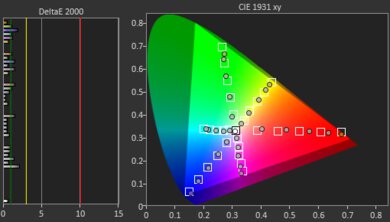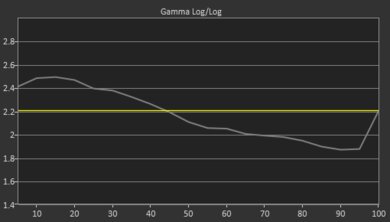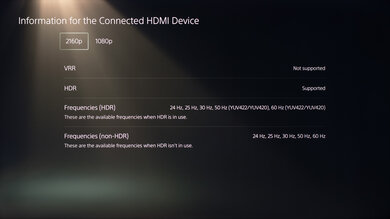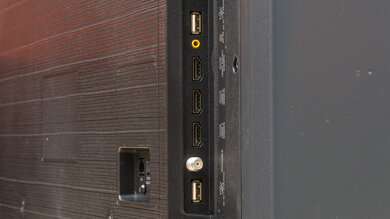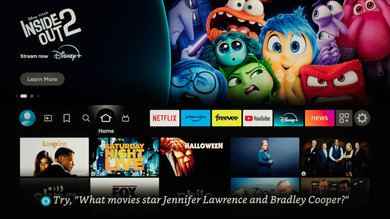The Hisense QD6/QD65NF QLED is a budget TV in Hisense's 2024 QLED lineup. It sits below the Hisense QD7N QLED, and, like that model, it lacks a local dimming feature. It's a more basic entry-level TV that's limited to HDMI 2.0 bandwidth and 4k @ 60Hz. There's no VRR to reduce screen tearing, either. On the upside, it supports Dolby Vision and Dolby Atmos. It features a 20W 2.0-channel built-in speaker system. The QD65NF is a Costco exclusive that's available in a wide range of sizes and runs Amazon's Fire TV OS. It's been replaced in 2025 by the more widely available Hisense QD6QF, which has similar overall specs.
Our Verdict
The Hisense QD6/QD65NF QLED is okay for mixed usage. It's best suited to dark or moderately lit rooms, with a decently high native contrast ratio that displays fairly deep blacks, but it lacks a local dimming feature to improve contrast, resulting in raised blacks when there are highlights present. It also doesn't get too bright, so it doesn't overcome glare in bright rooms. Its gaming features are pretty limited since it can only do 4k @ 60Hz and lacks VRR to reduce screen tearing. While it has low input lag, it doesn't have the fastest response time. Finally, its viewing angle is narrow, making it less suited to wide seating arrangements.
Dolby Vision support.
Good reflection handling.
Contrast suitable for dark room viewing.
Image quality degrades when you move off-center.
No local dimming feature to improve contrast.
Limited gaming features.
The Hisense QD6 QLED is passable for watching TV shows. It has good reflection handling, but it's best suited to moderately lit rooms since it doesn't get especially bright. It also has a narrow viewing angle that makes it less suitable for wide seating arrangements. Its picture processing is disappointing, as it doesn't upscale low-resolution content well and does little to smooth out artifacts in low-bitrate streams. Thankfully Fire TV is easy to use and gives you access to a wide range of apps.
Fire TV OS is smooth and easy to use.
Good reflection handling.
Image quality degrades when you move off-center.
Poor overall image processing.
The Hisense QD65NF is okay for watching sports. It doesn't have a wide viewing angle, so it's not the best option for watching the game with a big group. While it has good reflection handling, it isn't the brightest TV, so it's less suited to bright rooms. Its response time is also just okay, so there's a bit of noticeable motion blur with fast-moving sports.
Fire TV OS is smooth and easy to use.
Good reflection handling.
Image quality degrades when you move off-center.
Response time is just okay.
The Hisense QD6 is decent for playing video games, but it's best suited for casual gaming. It has low input lag for a responsive gaming experience, but its response time is just okay, so there's some noticeable motion blur and smearing. It's also limited to 4k @ 60Hz and can't display 1440p signals properly. Plus, it doesn't support features like VRR, so it can't take full advantage of modern gaming consoles.
Good reflection handling.
Low input lag.
Response time is just okay.
Limited to HDMI 2.0 bandwidth.
No VRR.
Can't display 1440p signals properly.
The Hisense QD65NF is alright for watching HDR movies. While it supports all HDR formats, including Dolby Vision, its contrast and HDR brightness are just okay, so it doesn't create a very impactful HDR experience. HDR content is displayed accurately for the most part, but the TV doesn't have good gradient handling in HDR, so there's noticeable banding between different shades. On top of that, it doesn't have the best picture processing, with poor low-resolution upscaling, and it can't remove judder from 60p/i sources.
Dolby Vision support.
Great PQ EOTF tracking.
eARC passthrough for most audio formats.
No local dimming feature to improve contrast.
Poor overall image processing.
Doesn't remove judder from 60p/i sources.
Not bright enough to make specular highlights pop.
The Hisense QD6 is decent for HDR gaming. It supports Dolby Vision and other HDR formats, but it doesn't get bright enough in HDR to really create an impactful HDR gaming experience. Its gaming features are also limited, with no VRR or HDMI 2.1 bandwidth to get the most out of modern gaming consoles. On the upside, it has low input lag, and its picture quality remains the same in Game Mode, although it doesn't have the most impressive picture quality to begin with.
Dolby Vision support.
Good reflection handling.
Low input lag.
Response time is just okay.
No local dimming feature to improve contrast.
Not bright enough to make specular highlights pop.
The Hisense QD6 is decent for use as a PC monitor. It has an okay response time, but there's some noticeable blur with quick mouse movements and fast-moving content. Thankfully, it has low input lag in PC or Game Mode, making for a smooth, responsive desktop experience. It doesn't get especially bright, so it isn't ideal for very bright rooms, but on the upside, it has good reflection handling. Its narrow viewing angle also makes the edges of the screen look washed out when sitting up close.
Good reflection handling.
Low input lag.
Displays chroma 4:4:4 properly.
Image quality degrades when you move off-center.
Response time is just okay.
BGR subpixel layout affects text clarity.
Can't display 1440p signals properly.
Changelog
-
Updated Sep 12, 2025:
We bought and tested the Hisense QD6QF, and added a comparison in the intro.
-
Updated Jun 20, 2025:
Mentioned the newly reviewed Hisense U65QF in the Contrast section.
-
Updated Nov 28, 2024:
We mentioned the newly reviewed TCL Q5/Q550F QLED in the Response Time section of this review.
-
Updated Oct 23, 2024:
We bought and tested the LG UT8000 and added a mention of it in the PQ EOTF Tracking section of the review.
Check Price
Differences Between Sizes And Variants
We purchased the 65-inch Hisense QD6/QD65NF QLED, but it also comes in 43-, 50-, 55-, and 75-inch sizes. The QD65NF is a Costco-exclusive variant of the QD6N Series that runs on Amazon's Fire TV OS. Hisense also sells a Hisense QD6N base model that comes with Google TV OS instead of Fire TV.
| Size | Model |
|---|---|
| 43" | 43QD65NF |
| 50" | 50QD65NF |
| 55" | 55QD65NF |
| 65" | 65QD65NF |
| 75" | 75QD65NF |
Our unit was manufactured in May 2024, as shown on our product's label.
Popular TV Comparisons
The Hisense QD6/QD65NF QLED is a decent budget option for the price, but it has little in the way of extra features. It has a 60Hz panel and lacks extra gaming features like VRR, so it isn't ideal for anything beyond casual gaming. While it supports most audio formats and HDR formats like Dolby Vision, it doesn't have local dimming to improve contrast, and its brightness falls short of creating an impactful HDR experience. If you're willing to stretch your budget a bit, the Hisense U6/U6N has much better contrast and more gaming features.
For more options, check out our recommendations for the best budget TVs, the best Hisense TVs, or the best QLED TVs.
The Hisense QD7N is better overall than the Hisense QD65NF, but it sits at a higher price point. The QD6 has a better native contrast ratio than the QD7, but the QD7 gets brighter and offers more features, especially for gamers, including HDMI 2.1 bandwidth and VRR.
The TCL Q651G is slightly better than the Hisense QD65NF. They trade blows on many aspects of image quality, as the Hisense has slightly better contrast and a slightly wider color gamut. In turn, the TCL is the more accurate of the two TVs in SDR and has better image processing overall. The biggest difference is in gaming performance, as the TCL has lower input lag than the Hisense, and the TCL has 120Hz support in 1080p and 1440p with VRR.
The Hisense U65QF is better than the Hisense QD65NF. The U65QF is brighter in HDR and SDR, and has a local dimming feature, giving it far better black levels than the QD65NF. The newer U65QF also has better colors and generally better image processing. One exception is its PQ EOTF tracking; it's quite bad, while the QD65NF excels here. For gamers, the U65QF is still the better TV, as it's capable of 4k @ 144Hz gaming, with VRR, while the QD65NF is limited to 60Hz at all resolutions, without VRR. Ultimately, the U65QF is the better product.
The Hisense QD65NF and the Hisense A7N are similar overall. Both are solid budget options for the price, but the QD6 gets a bit brighter in HDR and has better contrast, delivering slightly better overall picture quality. That being said, the A7N is a bit better for gaming, with a faster response time and VRR support, though neither TV is well-suited for modern gaming consoles since they lack HDMI 2.1 bandwidth and are limited to 4k @ 60Hz.

We buy and test dozens of TVs yearly, taking an objective, data-driven approach to deliver results you can trust. Our testing process is complex, with hundreds of individual tests that take over a week to complete. Most of our tests are done with specially designed test patterns that mimic real content, but we also use the same sources you have at home to ensure our results match the real-world experience. We use two main tools for our testing: a Colorimetry Research CR-100 colorimeter and a CR-250 spectroradiometer.
Test Results

The input housing on the back is made of plastic, while the rest is metallic. Most of the inputs are side-facing, but they're located towards the middle of the TV, making them hard to reach when the TV is wall-mounted. Unfortunately, the TV doesn't come with any accessories for cable management.
The TV has an okay contrast ratio. Its native contrast is great for dark room viewing, but the TV lacks a local dimming feature to improve contrast. As a result, blacks look washed out when highlights are present. You can get much deeper blacks from a TV with local dimming, such as the Hisense U65QF.
The Hisense QD6 doesn't have a local dimming feature, so it doesn't adjust the backlight of individual areas to brighten up highlights without impacting the rest of the image. This means that there are no distracting flickers or brightness changes as bright highlights move across the screen.
The Hisense QD6 has passable HDR brightness. It isn't bright enough to really make specular highlights pop. Even in darker scenes, highlights aren't too impactful because of the TV's limited contrast and lack of local dimming.
These measurements are after calibrating the HDR white point with the following settings:
- HDR Picture Mode: Movie
- Backlight: 100
- Color Temperature: Warm 1
- HDR Tone Mapping: On
All other extra settings were set to 'Off.'
We tested the TV with 'HDR Tone Mapping' set to 'On.' When it's disabled, the results are notably worse, with the image looking dim and washed out in real scenes, so we recommend keeping it enabled for HDR content. For reference, you can see the results with 'HDR Tone Mapping' disabled below:
- Hallway Lights: 334 cd/m²
- Yellow Skyscraper: 241 cd/m²
- Landscape Pool: 102 cd/m²
There's no noticeable difference in HDR brightness when the TV is set to Game Mode.
These measurements are after calibrating the HDR white point with the following settings:
- HDR Picture Mode: Game
- Backlight: 100
- Color Temperature: Warm 1
- HDR Tone Mapping: On
All other extra settings were set to 'Off.'
Results with 'HDR Tone Mapping' set to 'Off':
- Hallway Lights: 322 cd/m²
- Yellow Skyscraper: 233 cd/m²
- Landscape Pool: 88 cd/m²
As with our HDR Brightness testing, the TV's PQ EOTF tracking is significantly worse with 'HDR Tone Mapping' disabled, with everything appearing underbrightened. With 'HDR Tone Mapping' enabled, however, the TV performs great. Content mastered at every nit level is displayed quite close to the intended brightness, though darker scenes tend to be a tad underbrightened while brighter scenes tend to be a tad overbrightened. If you care more about accuracy than having a visually impactful image, check out the LG UT8000 instead.
The TV gets decently bright in SDR. It's not ideal for very bright rooms, but it overcomes glare in moderately lit rooms.
These measurements are after calibration with the following settings:
- Picture Mode: Movie
- Backlight: 100
- Contrast: 83
- Mid Luminance Gamma: -1
- Color Temperature: Warm
- All other extra settings set to 'Off'
The Hisense QD6 has a wide color gamut. It has near full coverage of the commonly used DCI-P3 color space, with great accuracy overall. Its coverage of the wider Rec.2020 color space, however, is just okay, and the colors are a lot less accurate.
The TV's color volume is decent. It doesn't display vibrant colors very brightly, and it struggles a bit with dark saturated colors, but it isn't bad overall.
The Hisense QD6 is fairly accurate in SDR before calibration. Most colors are displayed quite accurately, though whites are fairly inaccurate, and brighter reds and blues are somewhat off the mark as well. Its white balance is also quite inaccurate, with most lighter shades of gray and white having too much blue and red and most darker shades of gray having too little red, blue, and green. That said, the overall color temperature is close to our 6500K target. Gamma is off as well, with dark scenes appearing too dark and bright scenes appearing too bright.
After calibration, the TV's accuracy is great, but there are very few calibration settings, making it a challenge to calibrate. The white balance is particularly tricky to fix, so there are still some issues, especially in the darker shades of gray, but it's slightly improved. The color temperature is a smidge closer to target, and color accuracy is improved a bit as well, but the gamma remains mostly off.
See our full calibration settings.
The Hisense QD6 has decent gray uniformity. The edges of the screen are a bit darker than the center, but there isn't too much noticeable dirty screen effect in the middle of the screen. On a very dark or near-black screen, the uniformity is great, but the sides are a bit lighter than the rest of the screen.
It has good reflection handling. Its semi-gloss screen does an excellent job of reducing the intensity of indirect reflections, but it has a harder time with direct reflections from light sources positioned in front of the screen.
The Hisense QD6 has mediocre HDR gradient handling. There's noticeable banding in almost every shade, and it's particularly bad in lighter blue shades.
While we recommend enabling 'HDR Tone Mapping' for its better HDR Brightness performance, enabling it also results in worse HDR gradient handling. The above results were achieved with 'HDR Tone Mapping' disabled.
The Hisense QD6 does a poor job of upscaling low-resolution content like DVDs or low-resolution streams. There's a noticeable loss of fine detail, and the image looks soft overall.
Sharpness processing was calibrated with no over-sharpening for low-resolution content with the following settings:
- Sharpness: 5
- Super Resolution: On
The TV uses a BGR (Blue-Green-Red) subpixel layout instead of the traditional RGB layout. This doesn't cause any issues for video or gaming content, but it can be a problem for PC monitor use as it impacts the text clarity, although not everyone will notice this.
The TV uses a KSF phosphor coating to produce red light and a quantum dot color converter to produce green light, as confirmed by the TV's spectral power distribution (SPD).
The Hisense QD6 has an okay response time, but there's some noticeable blur behind fast-moving objects. It's especially sluggish with dark scene transitions. If you're looking for a TV with a faster response time, consider the TCL Q5/Q550F QLED instead.
The TV uses pulse width modulation (PWM) to dim its backlight, which introduces flicker that can bother people who are sensitive to it. It flickers at 180Hz in every picture mode when the backlight is set to '99' or lower. It's only flicker-free when the backlight is at maximum.
The TV doesn't have an optional backlight strobing feature, commonly known as black frame insertion (BFI), to help reduce persistence blur.
This TV doesn't have a motion interpolation feature.
The Hisense QD6 has some minor stutter when watching movies or TV shows shot at 24 fps, which is most apparent in slow panning shots, but there's almost no stutter with 60 fps content, which is good.
The TV can only remove judder from 24p sources, but it does so automatically without having to enable any settings. Unfortunately, it doesn't remove judder from 60p/60i sources like a cable box.
The Hisense QD6 doesn't support VRR to help reduce screen tearing.
The TV has very low input lag when set to PC or Game Mode, ensuring a very responsive gaming experience with little delay between inputs on your controller and the action on screen.
The TV supports most resolutions up to 4k @ 60Hz, except for 1440p signals. Unfortunately, it scales 1440p content to within a window at 2160p rather than scaling it properly. It's also worth noting that we couldn't get it to scale 480p sources properly when displayed via PC, but it does properly display native 480p sources like a DVD played on a DVD player. It displays proper chroma 4:4:4 when set to PC or Game Mode.
The TV is limited to HDMI 2.0 bandwidth on all three HDMI ports. It supports every HDR format.
The Hisense QD6 supports eARC, which lets you pass high-quality, uncompressed audio to a compatible receiver or soundbar through an HDMI cable. It supports most major audio formats, except for DTS-HD Master Audio. Still, you shouldn't have compatibility issues with most external sources.
The built-in speakers on the Hisense QD6 are okay, but if you really care about audio, you're better off getting a dedicated sound system or a soundbar. Like most TVs, the QD6 just can't produce enough bass for an impactful home theater experience. Otherwise, the frequency response in the mid and treble range is fairly balanced, so dialogue is pretty clear at moderate listening levels. The TV also gets quite loud, but the sound is less balanced at maximum volume.
Distortion isn't bad overall, especially at moderate volume levels, but it gets more noticeable at the TV's max volume.
The TV has a wide selection of apps, so it's easy to find your favorite content. You can also cast content from your phone onto the TV or play videos directly from a USB stick.
The remote is small and simple, with no numpad and dedicated app buttons for popular streaming services. It has a built-in mic for voice control through Amazon Alexa, which you can use to change inputs, launch apps, or even control other compatible smart home products but not to adjust the TV's settings.
















